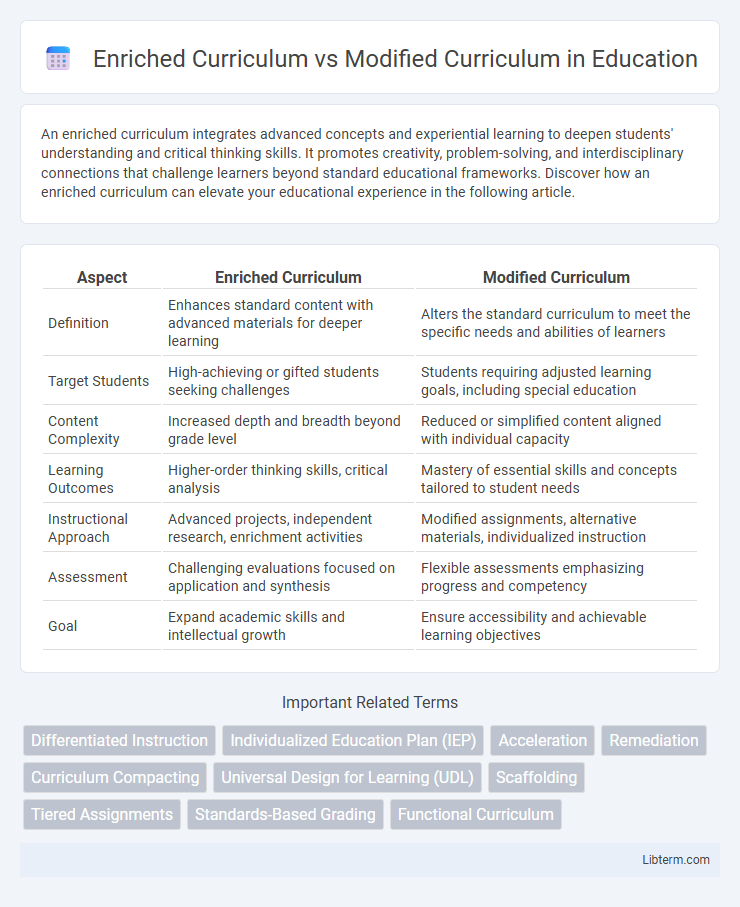An enriched curriculum integrates advanced concepts and experiential learning to deepen students' understanding and critical thinking skills. It promotes creativity, problem-solving, and interdisciplinary connections that challenge learners beyond standard educational frameworks. Discover how an enriched curriculum can elevate your educational experience in the following article.
Table of Comparison
| Aspect | Enriched Curriculum | Modified Curriculum |
|---|---|---|
| Definition | Enhances standard content with advanced materials for deeper learning | Alters the standard curriculum to meet the specific needs and abilities of learners |
| Target Students | High-achieving or gifted students seeking challenges | Students requiring adjusted learning goals, including special education |
| Content Complexity | Increased depth and breadth beyond grade level | Reduced or simplified content aligned with individual capacity |
| Learning Outcomes | Higher-order thinking skills, critical analysis | Mastery of essential skills and concepts tailored to student needs |
| Instructional Approach | Advanced projects, independent research, enrichment activities | Modified assignments, alternative materials, individualized instruction |
| Assessment | Challenging evaluations focused on application and synthesis | Flexible assessments emphasizing progress and competency |
| Goal | Expand academic skills and intellectual growth | Ensure accessibility and achievable learning objectives |
Understanding Enriched Curriculum: Key Features
Enriched curriculum emphasizes depth and complexity by offering advanced materials and activities that challenge students beyond standard grade-level expectations, promoting critical thinking and creativity. It integrates interdisciplinary content and project-based learning to enhance cognitive skills and foster intellectual curiosity. Designed for gifted and talented learners, enriched curriculum supports accelerated learning pathways while maintaining alignment with core educational standards.
Defining Modified Curriculum: Core Concepts
Modified curriculum involves tailored educational content designed to meet the specific learning needs of students with disabilities or learning challenges, ensuring accessibility without diluting essential grade-level standards. It focuses on adjusting the complexity, scope, or pace of instruction while maintaining alignment with key academic goals. Core concepts include individualized goals, simplified tasks, and alternative assessment methods to support meaningful participation and skill mastery.
Objectives of Enriched Curriculum
Enriched Curriculum aims to deepen students' understanding and critical thinking by providing more complex and challenging content beyond standard grade-level expectations. It focuses on fostering higher-order cognitive skills, creativity, and intellectual curiosity to promote advanced learning outcomes. This curriculum targets gifted and talented students seeking to enhance academic achievement through enriched educational experiences.
Goals and Purpose of Modified Curriculum
The goals of a Modified Curriculum focus on providing tailored educational experiences that accommodate students with diverse learning needs, ensuring accessibility and comprehension without diluting core content. This curriculum adapts the complexity, pace, and assessment methods to align with individual abilities while maintaining essential skill development. Its purpose is to promote meaningful learning outcomes and foster student success by addressing specific academic challenges and supporting inclusive education.
Target Learners: Who Benefits from Each Approach?
Enriched curriculum targets advanced learners seeking deeper knowledge and challenges beyond grade-level standards, often benefiting gifted and talented students. Modified curriculum suits learners with diverse needs, including those with learning disabilities or developmental delays, by adapting content complexity to support mastery of essential skills. Tailoring educational approaches ensures that enrichment fosters critical thinking for high achievers, while modification provides accessible pathways for learners requiring individualized support.
Teaching Strategies in Enriched vs Modified Curriculum
Teaching strategies in an enriched curriculum emphasize depth and complexity, using advanced materials, critical thinking tasks, and student-led inquiry to challenge gifted learners. Modified curriculum teaching strategies prioritize accessibility and foundational skills, adapting content and instructional methods to accommodate diverse learning needs and abilities. Differentiated instruction, scaffolding, and continuous assessment are central to both approaches, tailored either to extend student capabilities or support mastery of essential concepts.
Assessment Methods: Comparing Approaches
Enriched curriculum assessment methods emphasize higher-order thinking skills through project-based tasks, analytical essays, and creative problem-solving activities that challenge gifted students. Modified curriculum assessments focus on evaluating mastery of essential skills using simplified tests, oral responses, and practical demonstrations tailored to students with diverse learning needs. These differing approaches ensure assessments align with individualized goals, promoting both academic rigor and accessibility.
Impact on Student Outcomes
Enriched curriculum enhances student outcomes by challenging advanced learners with deeper, more complex material that promotes critical thinking and creativity, leading to higher academic achievement and engagement. Modified curriculum adjusts content, pacing, or objectives to meet diverse learning needs, improving accessibility and skill mastery for students with disabilities or learning difficulties. Both approaches positively impact student outcomes by personalizing education, with enriched curriculum driving academic excellence and modified curriculum ensuring equitable progress.
Challenges and Considerations in Implementation
Implementing an enriched curriculum necessitates addressing challenges such as ensuring student engagement without overwhelming learners, balancing depth with curriculum standards, and providing adequate professional development for educators to deliver advanced content effectively. Modified curriculum implementation requires careful consideration of individual learning needs, maintaining alignment with educational goals while adapting pace and complexity, and securing appropriate resources and support systems to assist students with diverse abilities. Both approaches demand continuous assessment and collaboration among educators, administrators, and families to optimize student outcomes and uphold inclusivity.
Choosing the Right Approach: Factors to Consider
Choosing the right approach between enriched curriculum and modified curriculum depends on student needs, academic goals, and learning abilities. Enriched curriculum offers advanced content and deeper challenges for gifted or high-achieving learners seeking intellectual stimulation. Modified curriculum adjusts content complexity or learning outcomes to accommodate students with diverse learning needs, ensuring accessible and meaningful education tailored to individual capabilities.
Enriched Curriculum Infographic

 libterm.com
libterm.com